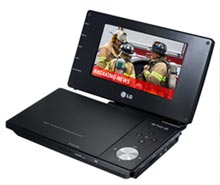TV on the Go, Faster Peripherals, and Wireless Power
3-D television and e-readers dominated the Consumer Electronics Show (CES) in Las Vegas last week. Sony, Panasonic, Samsung, and Toshiba all announced that they would sell 3-D TV sets this year, and a wave of new e-reader products were unveiled.

However, in the shadow of these products were other technologies that could shape the face of consumer electronics for years to come.
The first of these is mobile digital television, which would allow handheld devices such as smart phones to receive terrestrial digital television broadcasts. Until now, it’s been impossible to maintain a satisfactory reception on such devices because the digital television standard used by broadcasters assumes that television receivers don’t move around. This was reasonable enough in an era when the overwhelming majority of TVs had to be plugged into a power outlet to work. But low-power electronics capable of handling digital TV signals can now be crammed into a phone carried by a car passenger moving at 80 kilometers per hour.
Consequently, the Advanced Television Systems Committee, which develops digital television standards, announced in October 2009 the approval of a mobile standard tailored to moving receivers. And by last week’s CES, manufacturers and broadcasters were demonstrating the first consumer devices incorporating the new technology–including cell phones, plug-in TV receivers for laptops, and dedicated pocket televisions. Dell demonstrated the Mini 10 netbook with a mobile digital TV tuner built in, and iMovee is bringing out a range of related products, including the Car Telly for use in automobile entertainment systems.
Critical to the growth of mobile digital TV will be convincing local broadcasters to install the hardware required for the new standard. According to the Open Mobile Video Coalition, an association of broadcasters, the cost of upgrading digital television transmitters to handle mobile television will be minor compared to the money they have already spent moving from analog to digital systems over the last few years. In return, terrestrial broadcasters, who have seen satellite and cable companies consume most of the television audience, will reach new viewers who’d like to watch television on the go without having to pull video streams over congested wireless networks.
The mobile standard also incorporates provisions for interactive applications, allowing cell phone users to participate in, say, live news polls, or get more information about a product featured on a show or advertisement at the touch of a finger.
Another technology that will start to transform consumer electronics over the next year is USB 3.0. The first consumer products featuring this new generation of the technology–already used to connect printers, keyboards, cameras, scanners, and other peripherals to personal computers–have just reached the market. Several manufacturers showed prototypes of devices to come at CES. Seagate and Western Digital both showed off external disk drives, and HP and Fujitsu have announced notebooks that will support USB 3.0.
USB 3.0 has a maximum speed 10 times faster than the current standard, USB 2.0, with data transmission speeds of up to five gigabits per second. USB 3.0 uses a new cable design that includes nine wires instead of USB 2.0’s four, but it is backward compatible with the older design, at least on the personal computer end of the connection. The USB 3.0 connector on the other end of the cable will not be compatible with the older standard.
Finally, there was a strong uptick in the number of devices featuring wireless charging technology. These products operate on the principle of relatively short-range inductive coupling, originally pioneered as a way of transferring power through the air by Nikola Tesla at the end of the 19th century.
There have been a handful of wireless power systems every year at CES. But this year marked a turning point for the technology, as users’ frustration with short battery lives and bulky chargers met with improved industrial design. In the past, one of the big problems with inductive power was how to modify consumer devices to incorporate power receivers. The receivers have now been shrunk down enough to make this a minor issue. For example, with Powermat’s products, users can replace the battery cover of their cell phone with a slightly thicker cover that incorporates the receiver. Wireless power transmission could get a further push in the future if magnetic inductive coupling technology, a longer-range form of wireless recharging, takes off.
If a standard for wireless power could be developed, receivers and transmitters could be built into all kinds of devices, such as laptops and conference room tables. Then the days of hunting around for a power outlet at meetings could be numbered.
Keep Reading
Most Popular
Large language models can do jaw-dropping things. But nobody knows exactly why.
And that's a problem. Figuring it out is one of the biggest scientific puzzles of our time and a crucial step towards controlling more powerful future models.
The problem with plug-in hybrids? Their drivers.
Plug-in hybrids are often sold as a transition to EVs, but new data from Europe shows we’re still underestimating the emissions they produce.
How scientists traced a mysterious covid case back to six toilets
When wastewater surveillance turns into a hunt for a single infected individual, the ethics get tricky.
Google DeepMind’s new generative model makes Super Mario–like games from scratch
Genie learns how to control games by watching hours and hours of video. It could help train next-gen robots too.
Stay connected
Get the latest updates from
MIT Technology Review
Discover special offers, top stories, upcoming events, and more.